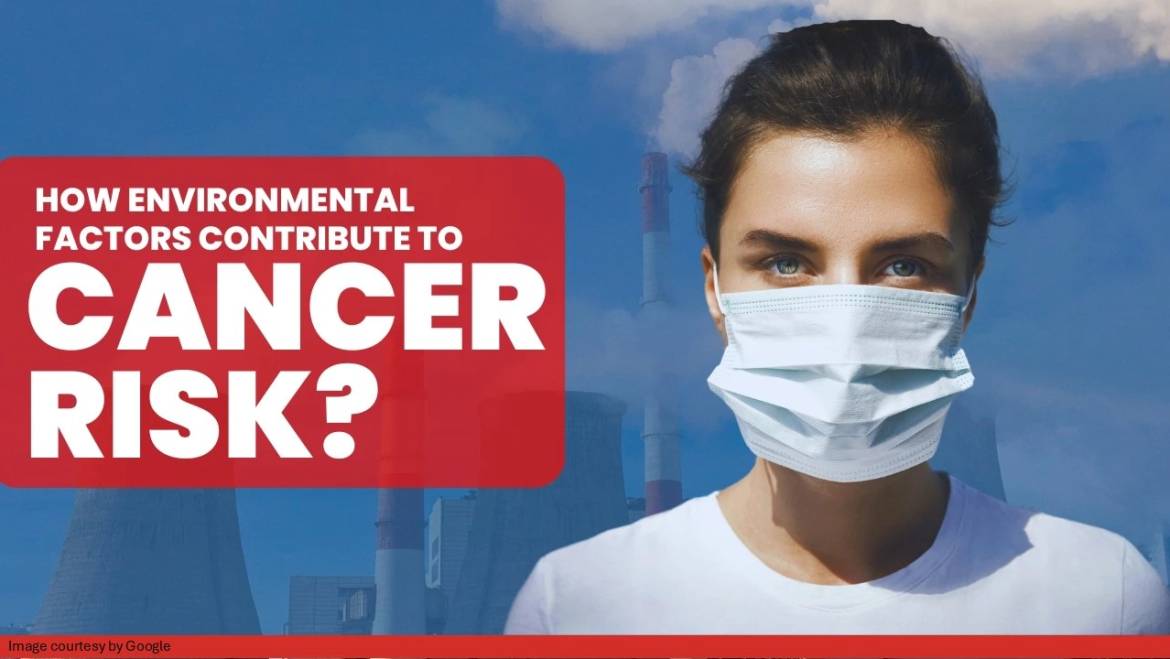Environmental factors are linked to the development of most cancers. This article addresses concerns about the association between cancer and exposure to toxic substances present in the environment. It will explain environmental factors that cause cancer, how cancer develops, and how exposure to certain chemicals affects the body.
Chemicals in the environment
Cancer develops over several years and can have many causes. Several factors, both internal and external to the body, can contribute to the development of cancer. According to scientists, everything outside the body that interacts with humans is the environment. When we discuss the environment, it encompasses not only water, air, and soil but also substances and conditions in the workplace, at home, in schools, and other places where people live, work, and play. These environmental factors may include lifestyle choices such as excessive alcohol consumption, cigarette smoking, excessive sun exposure, poor diet, lack of exercise, unhygienic living, accessively taking other forms of tobacco, and sexual behaviour that increase exposure to certain viruses. Moreover, exposure to certain medications, viruses, hormones, radiation, bacteria, and environmental chemicals that may be present in the air, food, water, and workplace also contribute to developing cancer. The cancer risk related to many environmental chemicals has been recognized through research studies of occupational groups that have higher exposures to these chemical components than the general population. Environmental factors of cancer, whether associated with lifestyle issues such as diet and smoking or exposure to cancer-causing agents (carcinogens) in the air and water, are believed to be connected to an estimated 80% to 90% of cases, as per reports released by the Nation Cancer Institute.
Types of environmental exposures
Air pollutants
Air pollution is a major environmental issue that has been associated with several detrimental health implications, including several types of cancer. Although there are different kinds of air pollutants, they can be categorized as either natural or anthropogenic. Industrial emissions, vehicle exhaust, power plants, agricultural activities, and home heating systems are considered the primary sources of pollution caused by humans. These activities ultimately cause the discharge of several harmful pollutants, including nitrogen oxides, carbon monoxide, particulate matter (PM), sulphur dioxide, and volatile organic compounds. On the other hand, natural sources of air pollution include volcanic eruptions, wildfires, and dust storms; however, these events are not frequent.
PM is considered one of the most harmful forms of air pollution because small particles have the potential to penetrate deeply into the respiratory system and enter the bloodstream. Heavy metals, organic molecules, carbon and other inorganic and organic components are often combined to form these particles. Research studies have shown a significant connection between long-term exposure to PM and increased risk of lung carcinoma. Further research suggests that exposure to PM may give rise to the development of certain cancer, which includes breast and bladder cancer. The mechanism of rise in PM involves DNA damage, oxidative stress, and inflammation.
Nitrogen oxides are one important class of air pollutants that are primarily released by vehicles and industry. Nitrogen oxide molecules, including NO2 and nitric oxide, are considered harmful to human health. Lung cancer risk has been associated with long-term exposure to increased NO2 concentration.
Volatile organic compounds readily evaporate into the atmosphere and can be found in various sources, including industrial operations, automobile emissions, solvent use, paint, and tobacco smoke. Benzene is a volatile organic compound with the most well-established cancer-causing characteristics. Benzene exposure may contribute to the incidence of leukaemia, especially acute myeloid leukaemia.
Sulphur dioxide is another major air pollutant formed by burning fossil fuels and industrial operations. Long-term exposure may increase the risk of lung cancer through respiratory tract irritation and affecting the inflammatory pathways.
Water contaminants
The contamination of water is another significant environmental issue with severe consequences, including an increased prevalence of various types of cancer. Sometimes, natural processes and human activities can contaminate water supplies, leading to the presence of hazardous compounds that have the potential to cause significant health hazards. Industrial chemicals, heavy metals, pesticides used in agriculture, and naturally occurring components like radon and arsenic are the common contaminants found in water.
Various means allow pollutants to enter water supplies, including industrial discharges, leaching from natural deposits, agricultural runoff, and improper waste disposal. Research reports have linked heavy metal contaminants, such as mercury, arsenic, cadmium, and lead that are present in water and can cause cancer. One of the potent carcinogens, arsenic, is naturally found in groundwater in many parts of the world. Long-term exposure to arsenic-tainted drinking water has been shown to cause an increased risk of cancers of the lung, skin, kidney, and bladder. Anti cancer medicines can enter the environment through wastewater and remain in aquatic ecosystems, not only affecting organisms but also contaminating drinking water sources.

Lifestyle factors (diet, physical activity) and cancer risk
The diet and level of activity of an individual are two major lifestyle factors that have the potential to affect the risk of cancer. It has been reported that certain foods and dietary patterns are associated with a higher or lower risk of specific malignancies. Specifically, a diet high in red and processed meats has long been related to an increased risk of colon cancer. These foods include cancer-causing agents such as nitrites and nitrates, which are used to preserve metals.
Alcohol consumption is another dietary factor that influences cancer risk. According to research studies, alcohol intake may increase the risk of cancer in the mouth, liver, colon, throat, and oesophagus. In addition, alcohol makes it tough for the nutrients to get absorbed and utilized, which increases the risk of cancer.
Exercise has a large impact on the risk of cancer. According to research studies, regular physical activity may reduce the risk of several types of cancer, including colon, prostate, endometrial, and breast. Physical activity helps to control hormone levels, including estrogen and insulin, which, when increased, can worsen the development and spread of cancer. Individuals with a history of specific cancers are vulnerable to cancer, causing the consequences of an unhealthy diet and inactivity.
Cancer concerns from everyday household essentials
Cancer causing agents can be found in various forms, including chemicals in household products. If household items prompt cancer concerns, then what household items cause cancer? Well, Items such as Nonstick cookware, mattresses, and cleaning products. Personal care products may increase cancer risk with long-term usage. If you are worried about your exposure to any of these common household items, the advice is simple: avoid the use of cancer causing household items and find alternatives.
Conclusion
The information guide clarifies the complete relationship between environmental exposures and cancer risk by combining information from various research studies and highlighting the household and environmental factors that cause cancer. The results highlight the importance of understanding these cancer exposures and reducing them to lower the global cancer burden.



